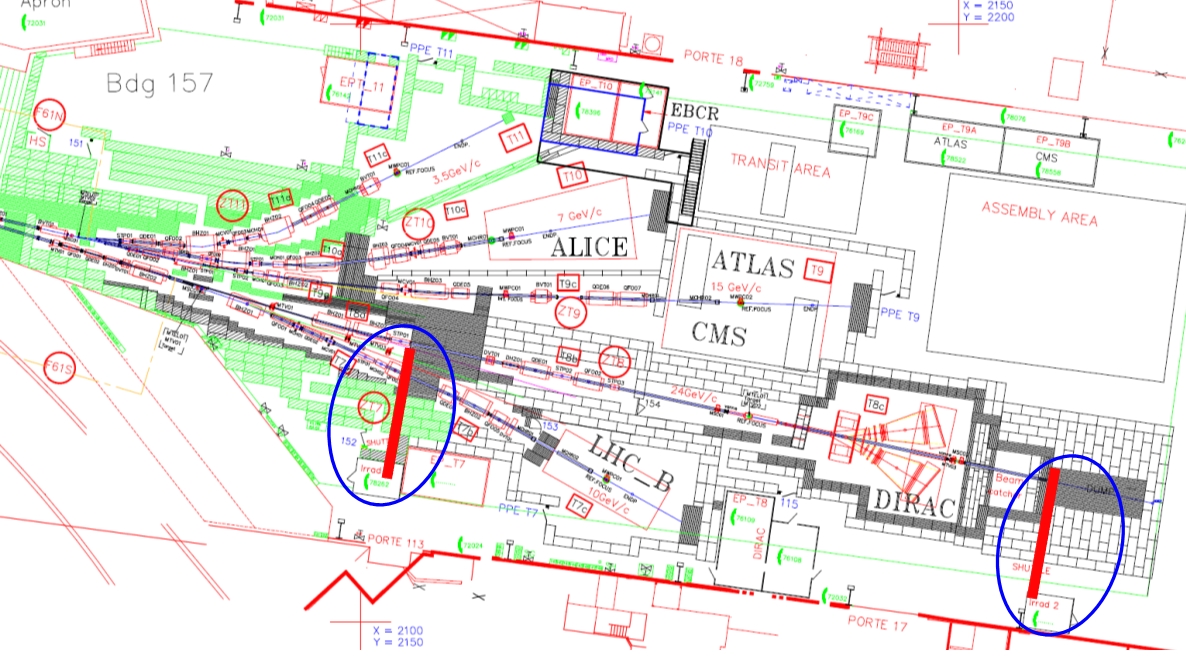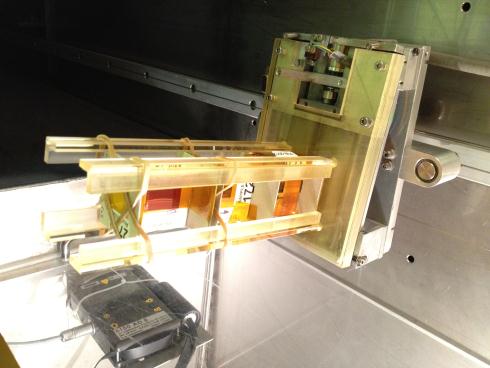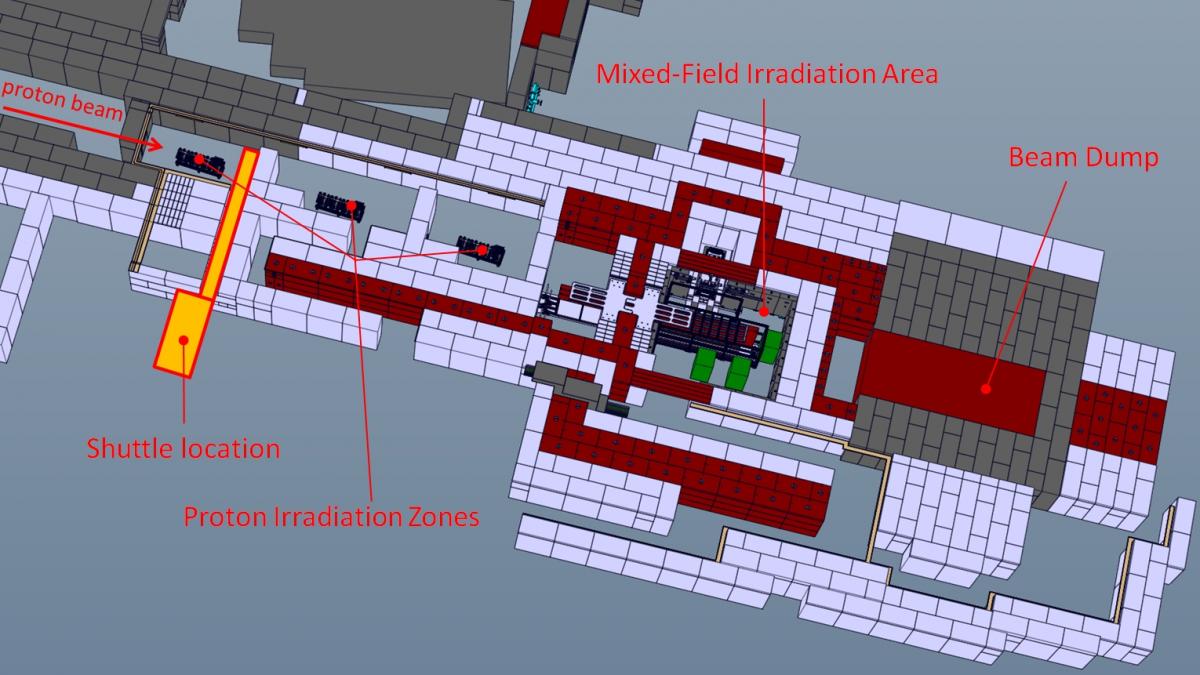The new proton & mixed-field Irradiation facility at CERN PS
Irradiation is the process by which an object is exposed to radiation. Although this term is fairly generic, the performing of irradiation experiments has a very important meaning for the PH department. In fact, the PH department is deeply involved in radiation tolerance testing since the early 90’s, when the RD2 detector collaboration began to exploit the T7 proton beam of the CERN PS East Hall for studying the radiation hardness of materials and semiconductor devices. Because of their potential for high-accuracy particle track location, silicon detectors appeared as an attractive prospect for the upcoming generation of high energy hadron colliders. However, the performance and electrical characteristics of silicon degrades with time during and after irradiation by hadronic particles such as protons and neutrons. In the LHC experiments these detectors must resist particle fluence of the order of 1014-1015 p/cm2 over their lifetime. Irradiation studies were therefore a pre-requisite before starting the design and the construction of the new particle detectors.
Following the enlargement of this R&D community (first RD48, later RD50) and together with the strong demand from the LHC experiments for testing all kind of detector prototypes, two irradiation zones were built at the end of 1998 in the East Hall experimental area using the 24 GeV/c primary proton beam of the CERN PS. The proton irradiation zone was built on the T7 beam, while the neutron zone was built at the end of the T8 beam downstream the DIRAC experiment (see Fig. 1). In the neutron zone, the irradiations were performed in a cavity with a mixed-field of secondary particles produced by the primary T8 beam after crossing a target composed of carbon, iron and lead. The dominating broad neutron spectrum generated therein was peaked slightly below 1 MeV and was representative of the energy of the neutrons present in the LHC experiments.

Figure 1: Layout of the PH Irradiation Facilities (proton & mixed-field) in the CERN East Area during the period 1998-2012. The proton area is located on the T7 beam (blue circle left-hand side), while the neutron area is on the T8 beam behind DIRAC (blue circle on the right-hand side).
Each irradiation zone was equipped with a remote-controlled shuttle system to move the samples from the counting room into the irradiation area without interrupting the beams for the other PS East Hall experiments. These systems were named IRRAD1 and IRRAD2 for the proton and neutron zone respectively (see Fig. 2). With the increasing number of irradiation experiments and sample size, a series of remote-controlled irradiation tables were also installed inside the proton area in order to meet the needs of a wider experimental community which nowadays exceeds the boundaries of the silicon detectors R&D. Full electronic systems, optical fibres, calorimeter crystals, glues and structural materials are just few examples of the variety of components tested every year at the PH Irradiation Facilities (see Photo Gallery).

Figure 2: The remote-controlled shuttle system IRRAD1in the loading position.
In the period 1999-2012, more than 8100 objects have been irradiated, together with thousands of dosimeter samples which provide the users with a precise and reliable particle fluence measurement. Together with the expertise in dosimetry and radiation monitoring, samples handling, traceability, storage and shipping are some of the services provided by the PH/DT team in the laboratory located in bld 14.
More recently, the PH Facilities served a wide international user community with main focus on activities related to the upgrade of the LHC and its Experiments. The upgrade projects generated an increasing demand for proton irradiation experiments and the need of reaching higher integrated particle fluxes (~1016-1017 p/cm2). Within this scenario, the present facilities were suffering from a number of unpleasant restrictions such as the space availability, a limited proton flux and a limited accessibility. During the same period, in the framework of the R2E project of the EN department, ad-hoc radiation test areas such as CNRAD and H4IRRAD were also built as an intermediate solution for testing and validating electronic systems to overcome radiation related problems and future upgrades required for equipment in the LHC underground areas. However, also for the A&T sector, only a dedicated test facility could serve the needs of the LHC equipment owners over the longer term period.
To satisfy these new requirements, the joint effort of both the PH and EN department in the framework of the AIDA projecti, brought forward the proposal for the upgrade of the East Area Irradiation Facilities (EA-IRRAD). The proposal, approved in 2012, consisted in moving the old proton facility on the T8 beam line and exploiting the area previously occupied by the DIRAC experiment which completed its data-taking period at the end of the same year. The construction project has now started: as shown in Figure 3, the new proton irradiation area is being installed at the former location of the DIRAC target, while the new mixed-field area will be upgraded downstream of the proton one.

Figure 3: Layout of the EA-IRRAD Irradiation Facilities (proton & mixed-field) on the T8 beam of the CERN East Area after LS1 [3D Model courtesy of M. Lazzaroni, D. Brethoux – EN/MEF]. The proton beam is entering the facility complex from the left side and passes the shuttle system and 3 irradiation table assemblies of the proton irradiation facility. After having passed the proton facility the beam enters into the mixed field facility where objects (indicated by the three green cuboids) are exposed to a wide spectrum of different particles.
1. the access to the facility is independent of the rest of the PS East Area;
2. the layout is optimised for exploitation as an irradiation facility, with appropriate shielding, ventilation, dedicated infrastructure and sufficient space for a proper installation and easy accessibility of the equipment;
3. the same protons can be used for both the proton and mixed field-area in parallel. This led to an optimal use of available protons to reach (in standard irradiation conditions) particle fluence about 4 times higher than in the old proton area.
The PH/DT team is focusing his work on the proton facility area: here a new shuttle system, cloned from the previous IRRAD1 and IRRAD2, will be installed together with a series of remote-controlled tables for the irradiation of large samples, detector components and prototypes. It will be possible to perform irradiations experiments on these tables also with samples maintained at low temperature (up to -15°C) and on powered equipment. The irradiation tables will be located in three separated shielded zones (~3×5m2 each) in order to minimise the impact of particle scattering during irradiation as well as to reduce the radiological impact to the personnel accessing the irradiation area. Finally, the proton facility will be also equipped with a cryostat that is fed with liquid Helium to allow special irradiations at cryogenic temperature down to 1.8K.
The EN team is focusing his work on the mixed-field facility area: there the particles coming from the upstream proton area interacts here with a 50cm long target of high-Z material. The resulting mixed particle field is optimized to reproduce the radiation environment of the LHC tunnel and the typical shielded areas of the CERN accelerator complex. A series of remote-controlled systems, currently under design, will position the equipment to be tested (power converters, beam instrumentation electronics, magnet components, etc.) inside the irradiation area of about 5×5m2.
The disassembly of the DIRAC experiment and of the old PH Irradiation Facilities in the PS East Area is currently on-going. This is expected to be completed by summer 2013. Next step will be the assembly of the new radiation shielding according to the new facility layout by the EN/MEF team which is responsible for the general infrastructure within the experimental area. Finally, the installation and commissioning of the new irradiation equipment will take place in the first semester 2014 with the goal to begin the exploitation of the new irradiation facility for the users of the PH experiments and the accelerator equipment owners at the end of LS1 during summer 2014.
The PS East Area upgrade Irradiation Facility core team is composed of: M. Glaser, M. Moll, F. Ravotti (PH/DT & AIDA), L. Gatignon, M. Lazzaroni (EN/MEF), M. Brugger, J. Mekki (EN/STI). PH/DT has also provided mechanical support for the work related to the proton area. Additional contributions come from EN/STI for the mixed-field area, and the EN-HDO, DGS/SEE and DGS/RP group for the project safety.
Further readings:
https://indico.cern.ch/categoryDisplay.py?categId=4451 (EA-IRRAD project meetings INDICO pages)
M. Glaser, et al., “New irradiation zones at the CERN-PS,” Nucl. Instr. and Methods, vol. A426, pp. 72-77, 1999.
F. Ravotti, M. Glaser and M. Moll, "Dosimetry Assessments in the Irradiation Facilities at the CERN-PS Accelerator," IEEE Trans. Nucl. Sci., vol. 53, no. 4, pp. 2016-2022, 2006.
M. Moll et al., "Future proton and mixed-field irradiation facilities with slow extraction for LHC operation phase and for LHC upgrade," CERN-LHCC-2010-007; LHCC-P-003, 2010.
i. AIDA stands for: Advanced European Infrastructures for Detectors at Accelerators. The AIDA project addresses infrastructures required for detector development for future particle physics experiments. In particular, task 8.3 is dedicated to the upgrade of PS irradiation facilities at CERN.
